There are plenty of cities in Mexico worth visiting other than Mexico City that have an immense amount of history and culture. This post will give you an insight into my experience visiting the different cities in Mexico. I had previously written about Mexico City, the various archeological ruins and cenotes/waterfalls/lakes that make Mexico a great place to visit. Now, I would like to talk about the following cities that I visited.
Jump to:
GUANAJUATO
There were 2 cities in Guanajuato that were on the top of our list of places to see and we couldn’t wait to start exploring these towns.
To get to Guanajuato, we had initially planned on renting a car because we had booked an AirBnB that was a little aways from the city center. Unfortunately, the car rental did not go according to plan. Although Uber is available in Guanajuato, we found that it is very hard to get drivers to come, especially out to where our apartment was. So eventually, we had our AirBnB host give us a ride to the city which took almost an hour because of traffic.
Guanajuato is one of the most beautiful cities in Mexico and is recognized as one of UNESCO’s World Heritage sites for its signature architecture, silver mines, and deep history. The city is built on the side of a hill and the centuries-old alleyways and Baroque buildings remain as functional businesses and homes. This makes for an extremely scenic setting to roam around, unlike anywhere else in Mexico. The best way to see the city is to ditch your map and GPS and just explore the quaint alleyways and pedestrian-only streets. Guanajuato is also a university town, so it is full of young people. This youthful presence lends to the city’s fun and festive atmosphere. And not to mention, the time we were visiting was also the week of Mexico’s Dia Del Muerto celebrations and all the decorations and shrines set up everywhere became part of a tourist spot in itself.
Although you could spend the entire day just roaming around the city, some of the places of interest from a tourist point of view are:
- Jardin de la Union: This is a triangle-shaped plaza that is opposite the San Diego church. Two of the sides are lined with restaurants, bars, and cafes and the third side opens onto De Sopena street. The most noticeable feature of the Jardin de la Union is the elegant square-cut trees which provide shade and a touch of greenery to the center of Guanajuato.
- Teatro Juarez: This is one of the most architecturally stunning buildings in Guanajuato with a design style inspired by Ancient Rome and Greece. The rows of steps that lead up to the grand entrance with the 12 stately pillars closely resemble the Pantheon of Rome. At the top of the roof stands 8 bronze statues from Greek mythology. The day we visited, the front of the theater was decorated for Dia de Muerto.

- Basílica de Nuestra Señora: Walking around Guanajuato, you will no doubt run into the beautiful yellow church on the centrally located Plaza de la Paz. Known as the Basílica de Nuestra Señora, the tall & towering church was constructed in 1671 and consists of a jewel-encrusted image of the Virgin Mary. On the day of our visit, we witnessed the priest blessing a young girl on her Quinceanera.
- Callejón del Beso: While Guanajuato has many narrow alleyways, this particular alley has a story behind it that is just as colorful as this city itself. The local legend tells of a young girl from a well-to-do family who fell in love with a poor miner boy that the family did not approve of. The boy rented the room exactly across this narrow alley from the girl’s room. At night they would sneak out to their balconies to kiss across this little alleyway. The boy would sometimes climb into the girl’s room and one night her father caught them in the act. In a fit of rage, the father stabbed and killed his daughter. Meanwhile, the boy tried to escape out the window but plunged to his death in the alleyway below. Like most urban legends, there are a few variations of this tragic tale but they all follow this same theme. Today the superstition lives on in which couples who smooch in Alley of the Kiss are rewarded with seven years of good luck!
- Templo de la Compania: This is another notable church of Guanajuato with an elaborate exterior and an equally impressive interior built by the Jesuits of Mexico in the mid-1700s.
- Museo de las Momias de Guanajuato: Although quite disturbing, one of the main attractions in Guanajuato is the Museo de las Momias (Mummy Museum). In the 1800s, there was a cholera outbreak that led to an increased number of deaths and hence burials. Decades later, the cemetery enacted a tax that family members needed to pay to keep their loved ones in the ground. Some didn’t pay and hence their relatives were dug up. It turns out that Guanajuato’s unique geology had naturally mummified these corpses. At some point, curious visitors wanted to see these mummies. So cemetery workers began charging for entry. They eventually built a museum to display the mummies, which is a top attraction in Guanajuato today.
It can be disturbing to see the 100+ mummies, many of which are so well preserved that you can still easily see their facial expressions. After all, Guanajuato’s mummies are only a little more than a century old. Many of the mummy’s family members are said to still live in the area today. The entrance fee is M 50 pesos and the museum is open from 9:00 am to 6:00 pm daily. - Guanajuato’s elaborate network of tunnels: These subterranean streets were initially built as a means to divert flooding, but today they are instead used to divert traffic out of the historic city center.
Being a busy weekend immediately following the Dia de Muertos holiday, Guanajuato was unusually crowded and it was nearly impossible to get an Uber on our way back. So we had to wait almost an hour in the rain to get a local bus to the central bus station from where we had to get a taxi to our apartment.
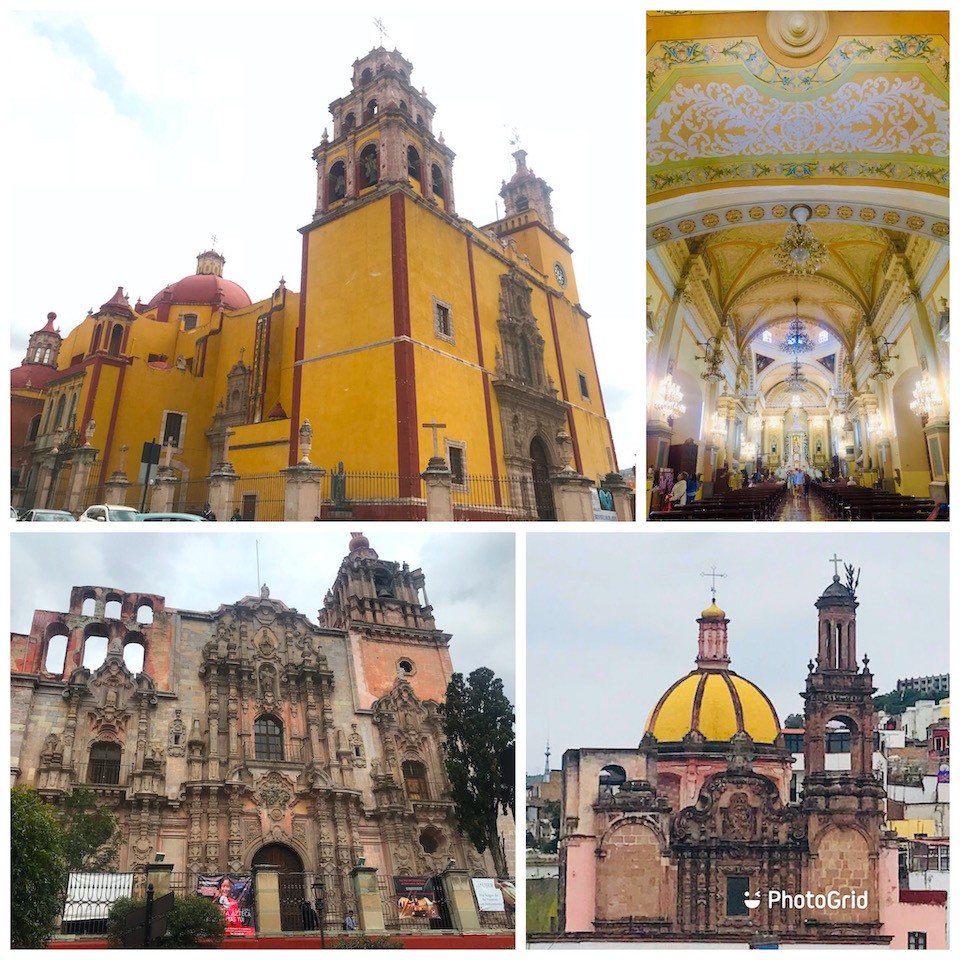
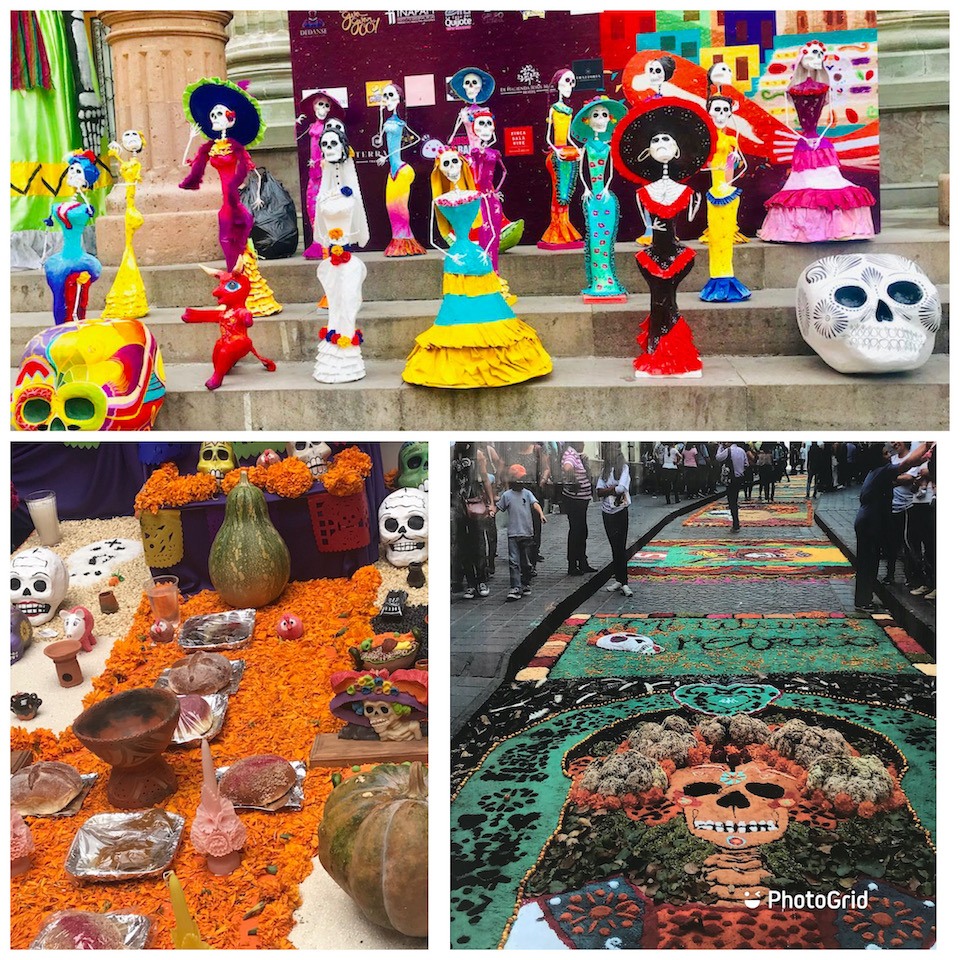
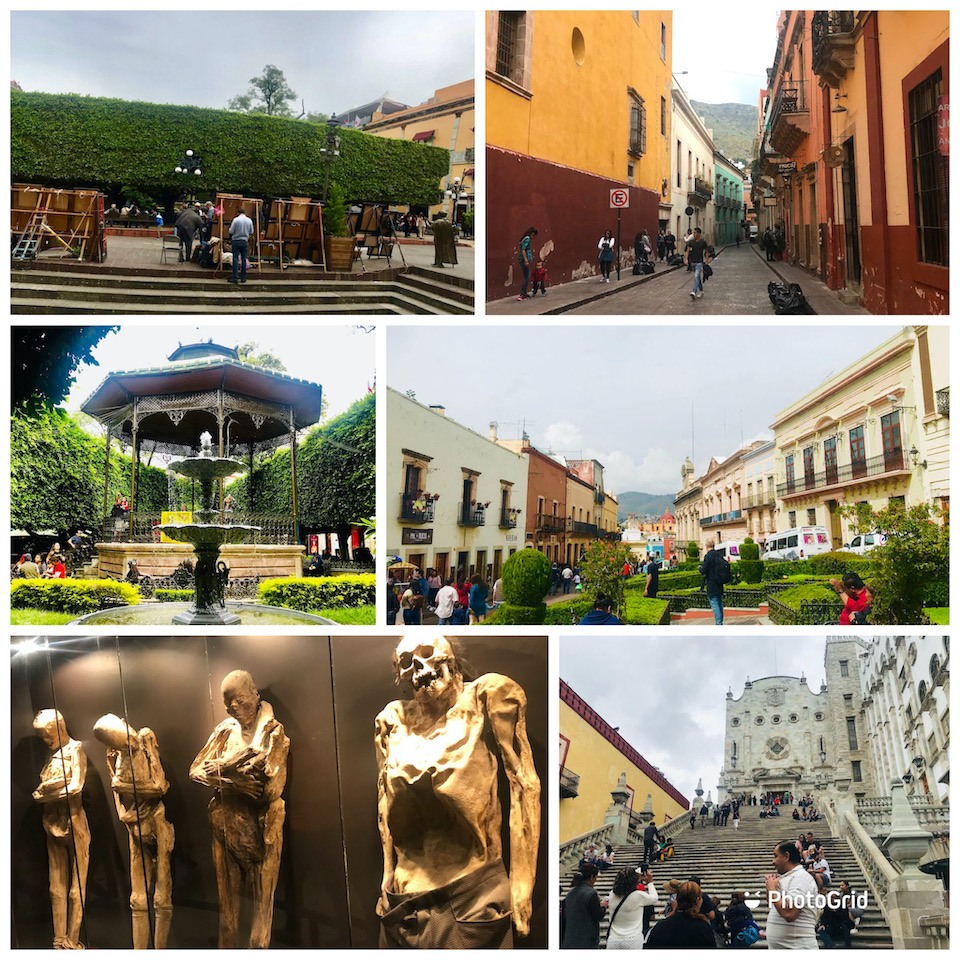
SAN MIGUEL DE ALLENDE
Today started with rain and continued the entire day. Our Airbnb host had offered to drive us to San Miguel de Allende in the morning as he had some work there. But unfortunately, he had a family emergency and so could only drop us to the central bus station.
ETN and Primera Plus bus companies run daily service every 3-4 hours to San Miguel de Allende. Primera Plus, although cheaper, was sold out, so we took the ETN bus which was 180 pesos each way per person.
The pitter-patter of rain was on the whole day and it dampened our spirits and our ability to enjoy the beauty of the city. You could say that the rain gave a magical look to the city but it was uncomfortable walking around in a raincoat and trying to see from under a hoodie and take pictures.
Did I mention that San Miguel de Allende was voted the BEST CITY IN THE WORLD in 2017 by Travel + Leisure magazine? It was also designated a UNESCO World Heritage site in 2008. The beautiful colonial architecture, cobblestoned alleyways, beautiful churches, gardens,
restaurants and cafes make this an ideal vacation spot and also a popular place for expats to move in and call it their home.
Some notable places to visit in San Miguel de Allende are:
- La Parroquia de San Miguel Arcángel: famous for its Gaudi style architecture is also the most photographed church in all of Mexico

- El Jardin de Allende: with its neatly trimmed laurel trees, located adjacent to the beautiful gothic church and museum and surrounded by restaurants, cafes, galleries. This is the social heart of the city, a venue for fiestas and live music and a popular meeting place, day and night.
- Museo Historico Casa de Allende: 18th-century home & museum to Ignacio Allende, a notable leader of Mexico’s independence movement.
- Templo del Oratorio de San Felipe Neri: this multi towered and domed 18th-century church with its pale-pink main facade is baroque with an indigenous influence.
- Templo de Nuestra Señora de la Salud: the church is located on Insurgentes Street near the new square and can be identified immediately by the large shell carved over the main entrance.
- Plaza Civica: built in 1555, this square was the hub of the town’s activity in its time, but today, a large statue of Ignacio Allende on a horse dominates the plaza.
- Templo de San Francisco: this 18th-century church, built in an architectural style known as ‘churrigueresque’, contains several pieces of well-known art.
- Mercado de Artesanías (The Artisan Market): is open from 9.00 am to 7.00 pm daily. Each stall is overloaded with hand-crafted items. Jewelry stalls selling pendants and rings made from local stones such as Mexican jade or shaped like skulls, hand-painted, traditional Mexican ceramics piled high alongside hanging lamps, colorful leather shoes called huaraches, Oaxacan rugs, and clothing. I was even able to score a beautiful pair of huaraches for my daughter for 380 pesos ($19) for which I had paid over $30 for a similar pair in LA’s Latin American market on Olvera Street.
The only disappointing part of our visit to this beautiful city was the choice of the restaurant we ended up having lunch at. While walking on one of the streets parallel to El Jardin, we saw a sign that said authentic home-style buffet lunch and with the thought of being able to sample a variety of dishes in a buffet, we decided to eat here. But this turned out to be a very small selection of not-so-authentic food and even among the few choices, nothing was really good. This was not a great meal and we came out hungry and even more disappointed with our choice. We had read that one of the biggest draws of this city is the numerous amazing restaurants, however it just didn’t work out for us.
As we had already purchased a return bus ticket for 6 pm, we made our way to the bus station for our ride back to Guanajuato.
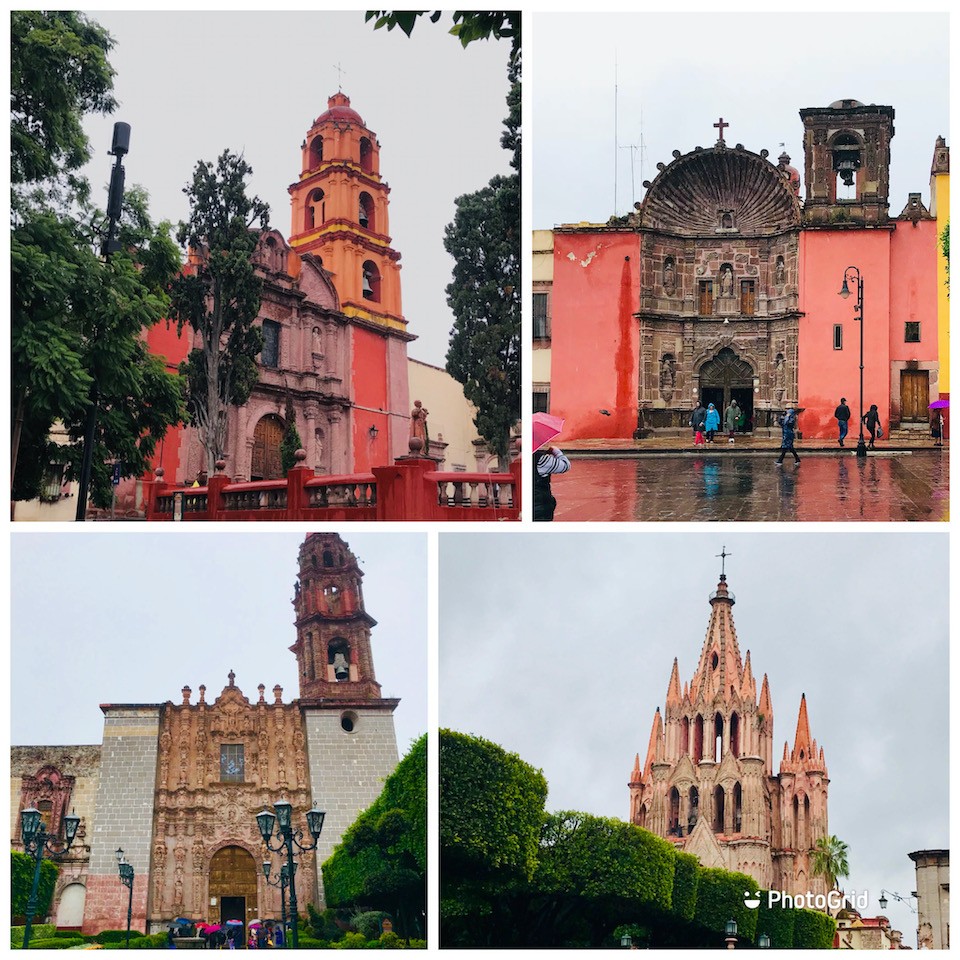
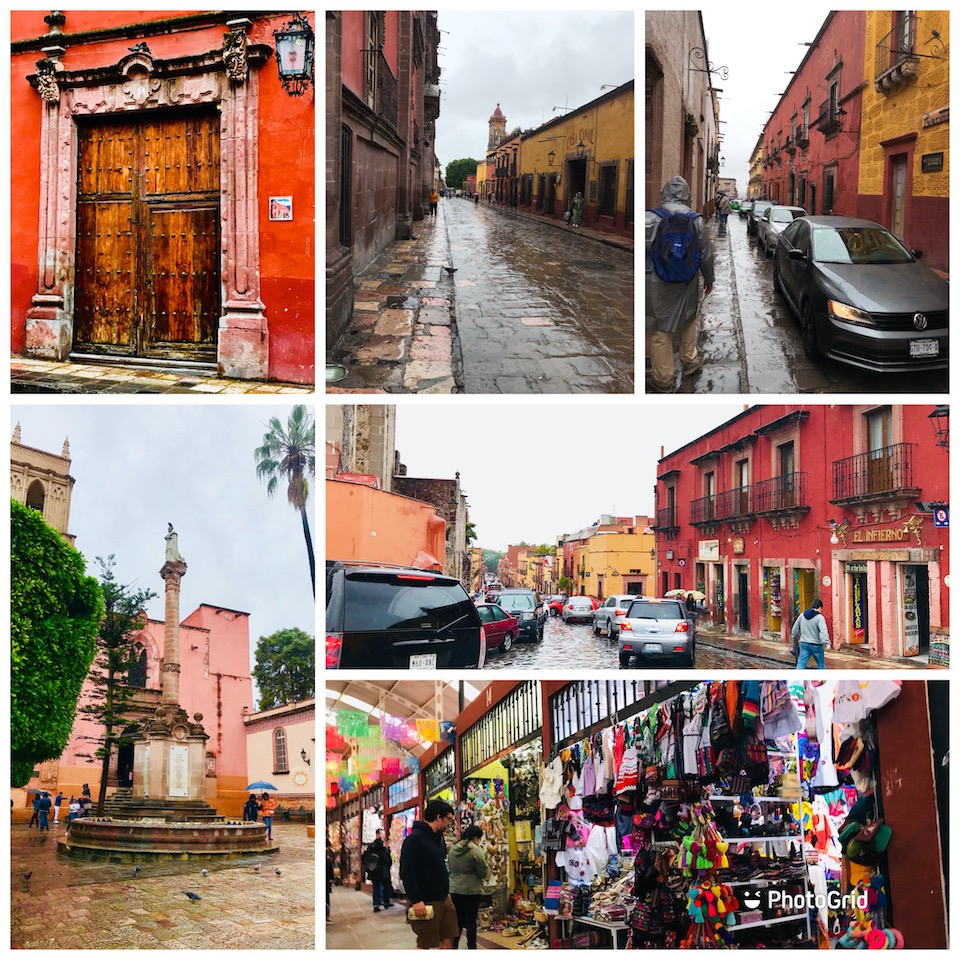
VERACRUZ
The city of Veracruz, also known as Heroica Veracruz, is a major port city located along the coast. This was the point of entry for the Spaniards back in the early 1500s, when Spanish explorer Hernán Cortés landed in Mexico. It was the first Spanish settlement on the mainland of the Americas from where they began their conquest of Mexico. Although not a popular tourist destination, parts of the city still bear witness to this part of history. Fort San Juan de Ulúa is located on an island, now connected to land of the same name. For hundreds of years San Juan del Ulúa served as the primary military stronghold of the Spanish Empire in the Americas. The Baluarte de Santiago (Santiago Bulwark) was built in 1635 and now is the only visible remnant of the defensive wall that once surrounded the port city.
To see the city, take a stroll around the Plaza de Armas commonly called the Zocalo. This tree-shaded square is bustling from morning to night with people playing dominos, selling food, and cigars, playing music, dancing and other activities. It is surrounded by the Municipal Palace, the Cathedral of Veracruz (Catedral de la Virgen de la Asunción), and several restaurants and hotels.

A short walk from here is the Naval Museum and Museo de la Ciudad which houses one of the sixteen original Colossal Olmec heads. If you walk towards the port, you will find the malecón (boardwalk) which stretches for kilometers along the Gulf of Mexico. This area is popular at night, when people stroll and exercise, enjoying the ocean breeze. Near the city center, the malecón is crowded with merchants selling souvenirs. Just south of the city of Veracruz is Boca del Rio, a port city and a popular beach destination with resorts and upscale hotels and restaurants.
Veracruz has a lot of history and there are a lot of things to see within the state which require a bit of driving. So we rented a car for four days during the remainder of our stay here which gave us the freedom to set our own timetable. There are some spectacular ruins, waterfalls, heritage cities, beaches, etc which makes Veracruz an interesting place to visit. We visited the ruins at El Tajin, Cempoala and Quiahuiztlan which you can read about here. We also drove to Cascada de Texolo and the city of Xalapa and visited the Museo de Antropologia.

Colossal Olmec heads in Xalapa
This is a very beautiful museum with lots of great exhibits, but due to lack of time, we only saw notable pieces such as the Colossal Olmec heads. Six out the seventeen heads found to date are located in this museum. The Olmecs are an ancient Mesoamerican civilization dating back to the Stone Age, are far ahead of the Mayans and Aztecs in sculpting and carving, and are also known for producing some of the best artwork in the Mesoamerican era.
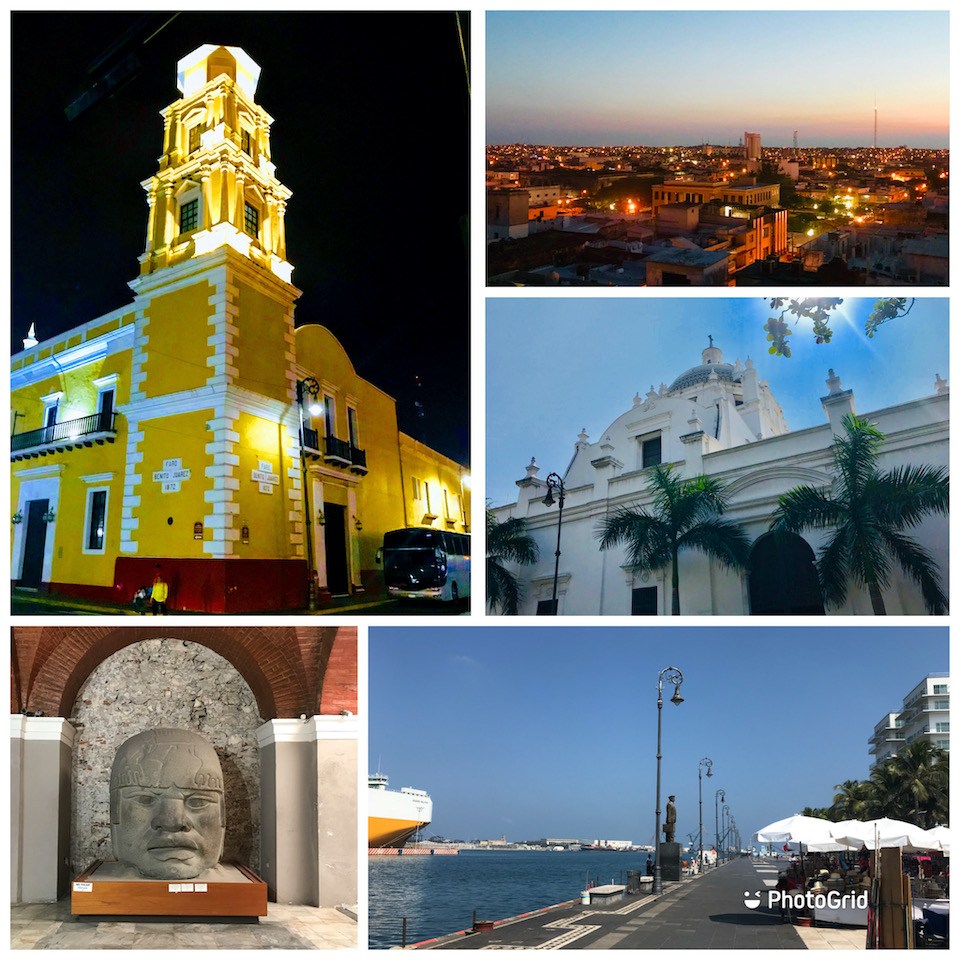
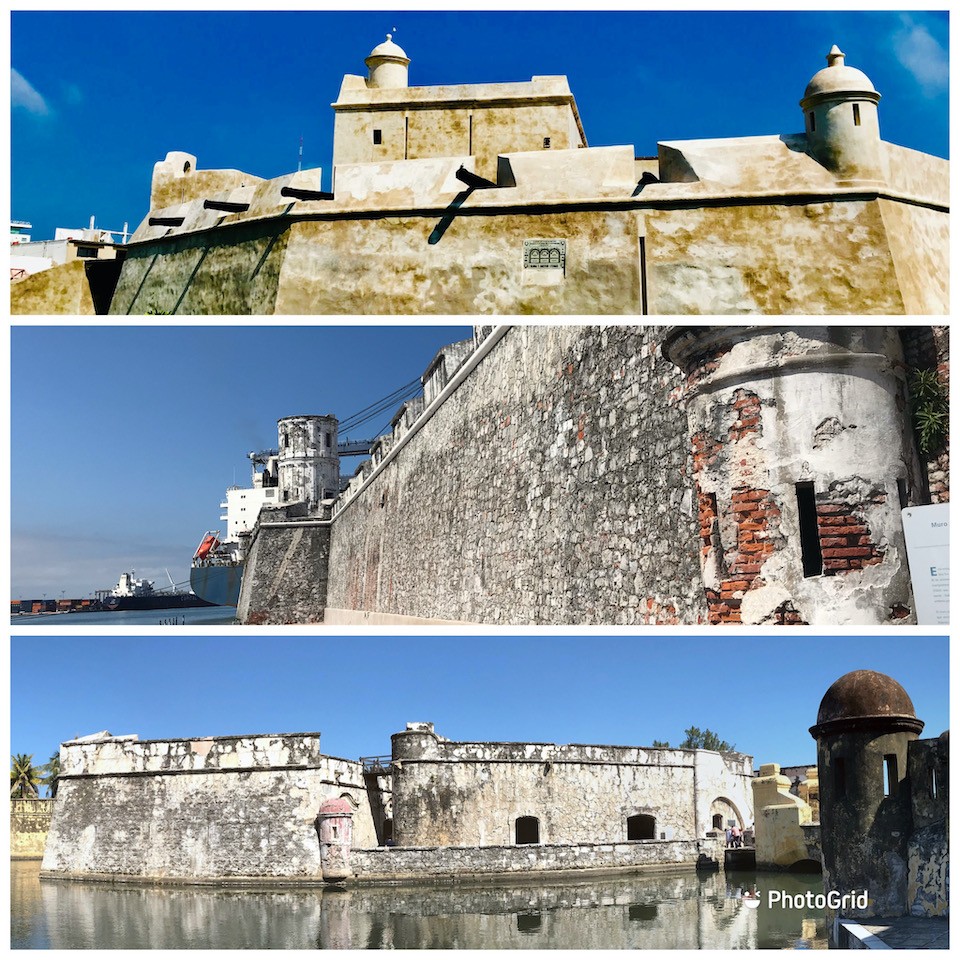
TLACOTALPAN
Tlacotalpan is a town about 100 km from the city of Veracruz, declared a UNESCO World Heritage site in 1998 primarily for its architecture and colonial-era layout. Located on the banks of the river Papaloapan, it is an exceptionally well-preserved colonial interior river port. It’s wide streets are lined with colonnaded houses that reflect Caribbean tradition with exuberant decoration and color.
This is one of the prettiest towns I have seen with its bright and bold colored buildings. We visited this town on an extremely windy day which may have been the reason why the town seemed really empty. It did however make for great crowd free pictures.

The colorful houses of Tlacotalpan

Church and the main square
OAXACA
The southern state of Oaxaca with its capital city of the same name is also a UNESCO world heritage city in recognition of its historic buildings and monuments. The city relies heavily on tourism, which is based on its large number of colonial-era structures as well as the native Zapotec and Mixtec cultures and archeological sites. Oaxaca was the birthplace of two of Mexico’s most important presidents, Benito Juárez and Porfirio Díaz, who made a significant impact on the country’s history. President Benito Juarez, who is of Zapotec origin, grew up in these parts and several buildings including the school and university are named after him. Even the house he grew up in has been converted to a museum which showcases the furniture and decor of the time.
Oaxaca is a beautiful city with numerous churches. There is the Cathedral de Oaxaca. Four blocks north is the church and former monastery of Santo Domingo de Guzmán. The Basílica de Nuestra Señora de la Soledad is located four blocks west of the Cathedral.
- Catedral de Oaxaca: also referred to as the Cathedral of Our Lady of the Assumption. This Neoclassic style church was built in the early 1700s for the third time because the first two versions were destroyed by large earthquakes. Its facade is made of green cantera stone commonly found in Oaxaca and the altar features a statue of Our Lady of the Assumption made in Italy.

- Templo de Santo Domingo: Founded by the Dominican Order, this baroque style cathedral took almost 200 years to build, breaking ground in 1575 and completed in 1731. It is very popular because of its highly ornate gold leaf ceiling. The heavily gilded interior was made using more than 60,000 sheets of 23.5-karat gold leaf.

- Basílica de Nuestra Señora de la Soledad: A baroque style church built between 1682 and 1690.

Food and Drink
Oaxaca is also home of the famous mole sauce. Oaxacans take pride in the creation of this sauce which has various versions and a complex list of ingredients, including chocolate. While moles can be found in other parts of Mexico, Oaxaca has the greatest variety including negro (black), colorado (red), coloradito (faint red), chichilo, verde (green), amarillo (yellow), and manchamanteles (lit. ‘stainer of tablecloths’). Due to the complexity of ingredients, moles are best bought readymade and there are plenty of shops selling them here. The other popular item you find here is the Oaxacan chocolate sold in bars mainly used for cooking.
Street foods include the traditional ‘Oaxacan Tlayudas’, which are large, slightly crispy corn tortillas piled high with ingredients such as grilled beef (called tasajo), cheese, tomatoes, avocados, onions etc. One of the best places in Oaxaca to eat tlayudas is Tlayudas El Negro (located at Vicente Guerrero 1029, Zona Feb 10 2015, Obrera, 68115 Oaxaca, Oax., Mexico), which is packed every evening with those who can’t get enough of this dish.
This place was quite close to our apartment and came highly recommended by our AirBnB host. Govi didn’t care for it much while I thought it was pretty good, but it was quite large and hard to finish. It was almost like the size of a stromboli and tasted like a crispy stuffed quesadilla.
As for alcoholic beverages, this area is home to ‘Mezcal’, as agave is grown abundantly here. Several distilleries offer Mezcal tasting and you can also learn how they make it.
One of the best restaurants we went to during our entire 2-month Mexico trip was to a little boutique restaurant called Casa Taviche in Oaxaca. I highly recommend this place if you are in Oaxaca. We actually loved it so much that we went there again. The decor is very cute, containing wooden furniture with little painted accent designs and the theme is carried throughout the restaurant. The food is delicious and not at all expensive. They offer traditional Oaxacan food with a modern twist and present them beautifully. The menu changes everyday and is presented in a little handwritten notepad. It consists of one 4-course meal of the day which includes soup or salad, a main course, flavored water of the day and a dessert all for 85 pesos (USD $4.50). You can also order individual a-la-carte items from the menu which again changes every day. During both our visits we ordered one 4-course meal and one other dish from the menu and we loved every one of those items. Do try this place if you happen to come to Oaxaca, you will not be disappointed.
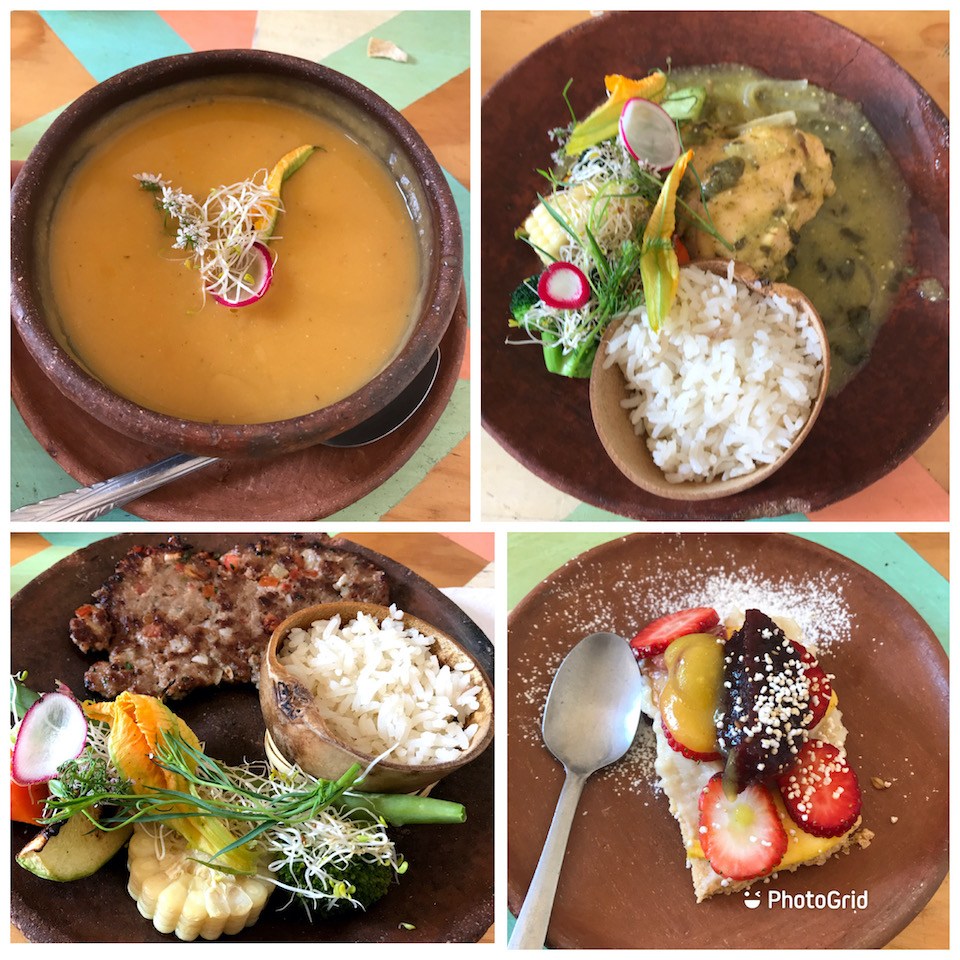
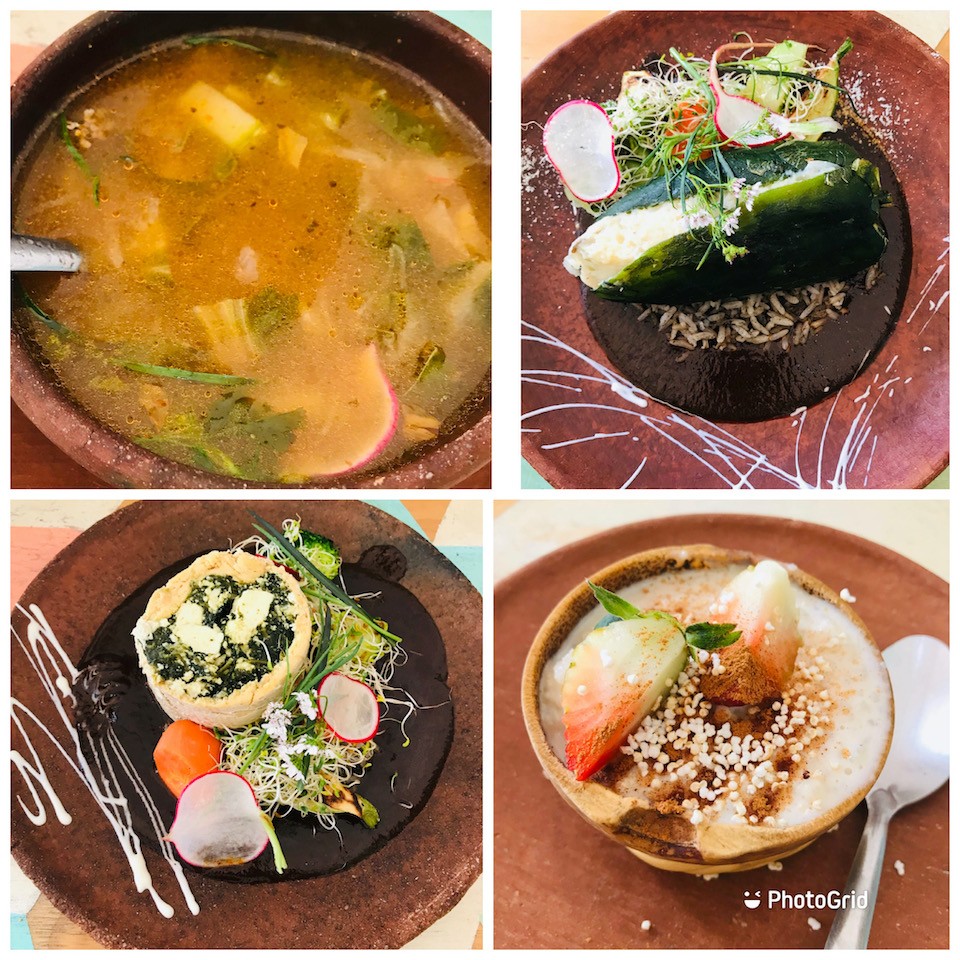
SAN CRISTÓBAL DE LAS CASAS
It is easy to see why travelers who visit San Cristóbal de Las Casas call it their favorite city in Mexico. Not only is it a starting point for all the wonders that the state of Chiapas holds, the city exudes charm with its cobblestoned streets, colorful houses with wrought iron balconies and plant pots. It also has a large population of indigenous people which adds to the cultural flair. Although the political capital of Chiapas was moved to Tuxtla at the end of the 19th century, San Cristóbal is considered to be the “cultural capital” of the state. There are plenty of things to do in San Cristóbal de las Casas and the best way to learn about it is to go on a free walking tour. The amount of information offered, hidden nooks and crannies to explore is well worth the 3+ hours it takes to complete this tour. Some of the beautiful sights this city has to offer are:
- The Cathedral: This is the main church of San Cristóbal but due to major structural damage due to a recent earthquake, this church was closed for renovation. However, the main feature of this church is its façade. Built in 1721 after tearing down the 16th century original church, the style consists of European baroque, Moorish and Indigenous influences. The entire exterior is painted yellow with ornamental columns and niches which contain statues of various saints and is further decorated with intricate raised stucco work.

- Cathedral Plaza: a large square in front of the Cathedral and is also the central hub of the city. The main plaza is to the south of the Cathedral and its official name is Plaza 31 de marzo, but is commonly known as the Zócalo.

- Iglesia Santo Domingo: is a beautiful church located four blocks north of the Zocalo and is of baroque style with elaborate stucco work. There is also an artisanal market in front of the church which sells handicrafts made by the local indigenous people.

- Iglesia de Guadalupe: this church dedicated to the saint of Guadalupe is located on top of a hill. Climbing the yellow and white painted steps will bring you to the top of the cerro de Guadalupe from where you get a beautiful panoramic view of the city.

Sights outside of San Cristobal de las Casas:
There is plenty to see in Chiapas. We took two tours to visit these sites. The first one (400 pesos/person) was to Sumidero Canyon and Chiapas de Corzo. We started our tour from the tourist office in the Zona Centro in the morning, and after picking up the rest of the passengers around the city, we departed towards Tuxtla Gutierrez. When we reached the embarcadero, we took a boat (ticket price included in the tour price) to Sumidero Canyon. The boat ride lasted around 2 hours and travelled along a 13 km stretch giving an awe-inspiring view of the canyon with its menacingly high walls. Sumidero Canyon is a deep natural canyon in the southern state of Chiapas, caused by a crack and erosion of the Grijalva River. Erosion that began around the same time as the Grand Canyon has walls rising up about 1000 meters on either side. We also saw some pretty animals resting on the banks of the river.
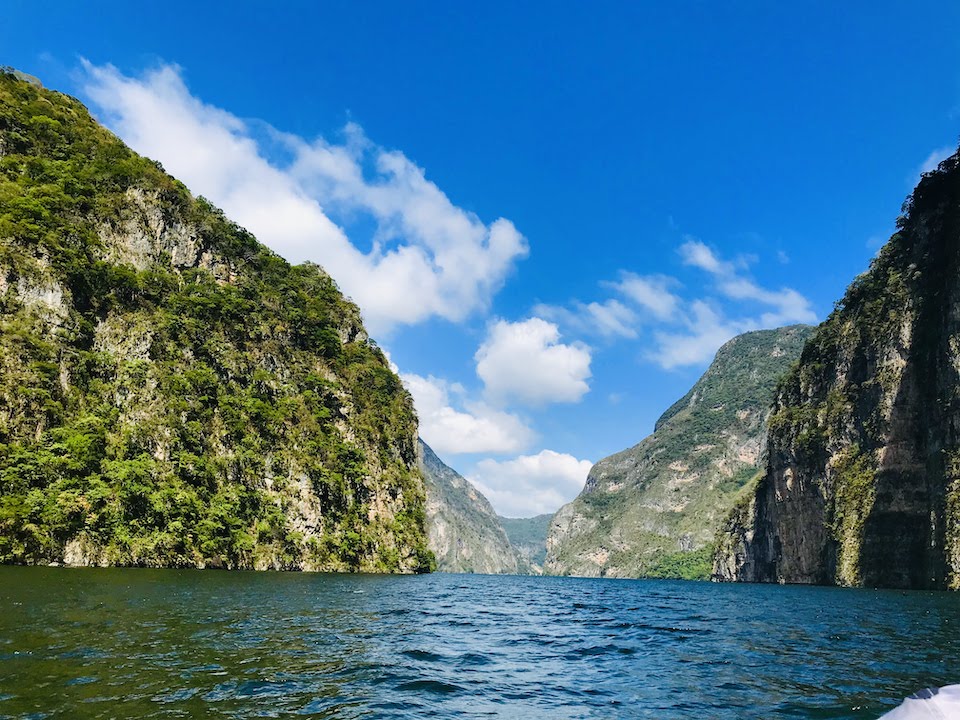
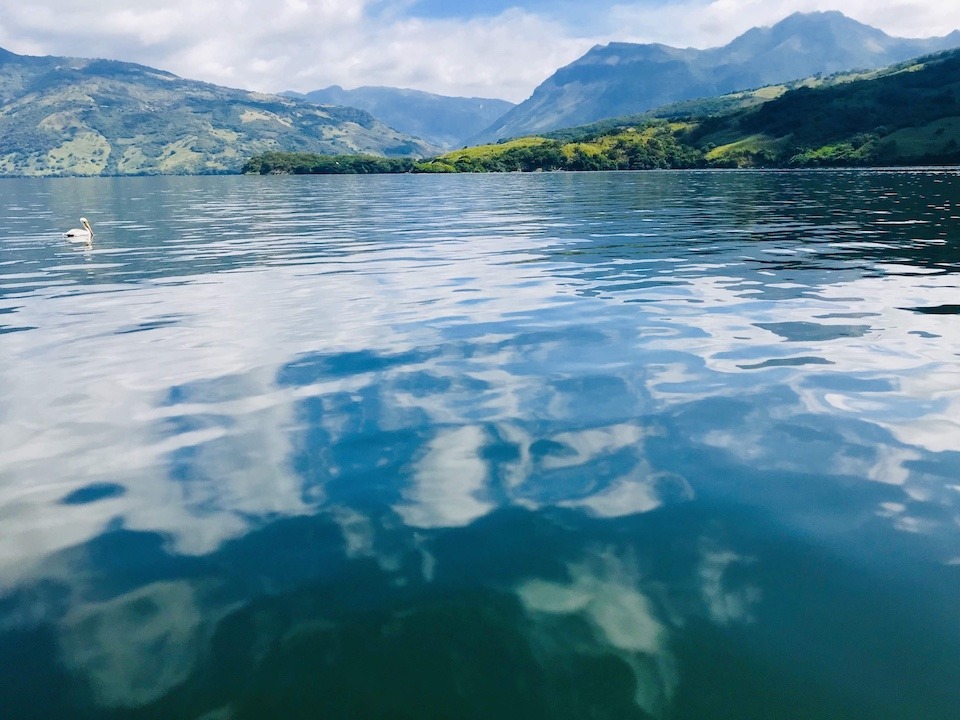
After this, we visited the Zocalo in the town of Chiapa de Corzo located along the banks of the Grijalva River. This Zocalo or plaza claims to be larger than the Zocalo in Mexico City.

The most notable feature of this plaza is the Moorish style La Pila fountain located in the center, made of brick in the form of a diamond. Another feature is a clock tower which was constructed in the 1950s. The town’s main structures are centered on this plaza, including the municipal palace and the former home of Liberal governor Angel Albino Corzo, for whom the town is named. One side of the plaza is taken up by the “portales”, a series of arches initially built in the 18th century, which contains a number of businesses.
The next tour we took was to Lagunas de Montebello National Park and Cascada de El Chiflon. Located around 150 km from San Cristóbal de las Casas, Laguna Montebello is a group of lakes near the Guatemalan border. Cascada de El Chiflon is a beautiful cascade waterfall which should not be missed.
MÉRIDA
Mérida is the capital and largest city in the state of Yucatan. The city also has the highest population of Indigenous people within any large city in Mexico, about 60% being of Mayan origin. Merida also has one of the largest Centro Historico areas, with every street dotted with colonial buildings, albeit not all in perfect condition.
As usual we planned to start our tour of the city with a free walking tour which was supposed to begin at the main square called the Plaza Grande. Most of the notable historic buildings surround the Plaza Grande such as the Catedral de San Ildefonso, Museo Casa Montejo and the Palacio de Gobierno.
- The Catedral de San Ildefonso: This was built in the 1500s with Renaissance architecture and partially built with stones from Mayan ruins.

- The Museo Casa Montejo: This stately restored 16th century house-turned-museum features art exhibitions & cultural events.
- Palacio de Gobierno: This is a beautiful building that houses government offices and a tourist office. You can also find wonderful murals and oil paintings by local artist Fernando Castro Pacheco housed in a magnificent sala (hall). Completed in the late 1970s, they portray a symbolic history of the Mayans and their interaction with the Spaniards and give excellent context to any trip around the region.
- Paseo de Montejo: This is a notable avenue in Merida and is the location of some of the most iconic buildings and monuments in the city. Many beautiful mansions were built along the avenue by wealthy Yucatecans of the 19th century.
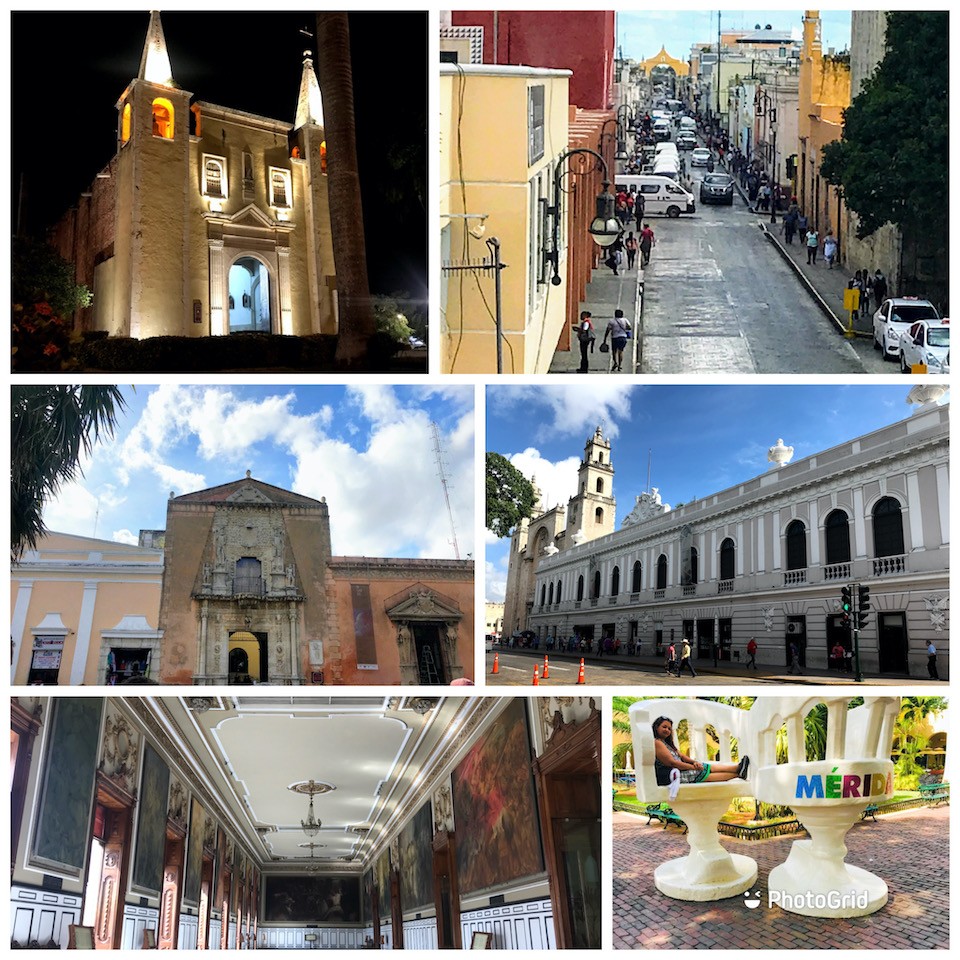
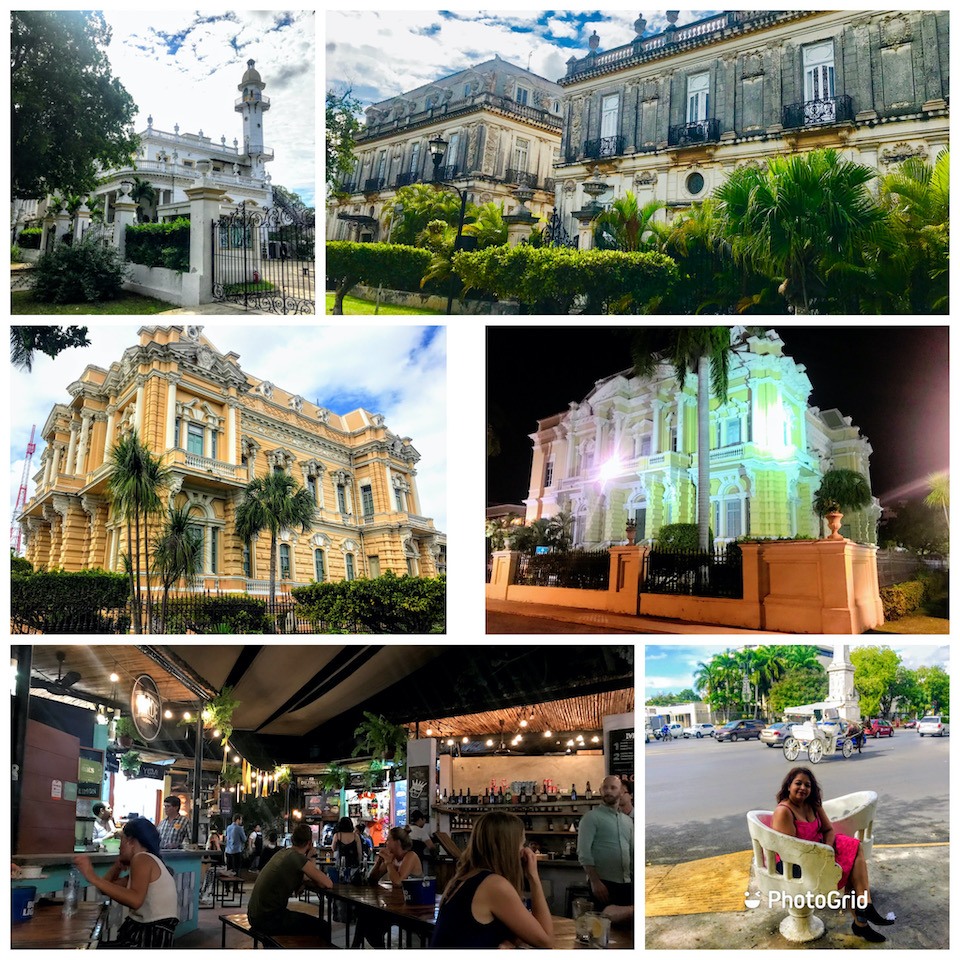
We also signed up for two day tours from Merida:
- The Yellow city of Izamal, Yokdzonot Cenote, Chichen Itza and Valladolid
- Los Coloradas (Pink Lagoon) and Rio Lagartos
After talking to several tour operators, we were able to negotiate a package for both tours for a price of 1400 pesos/person (approximately $73 USD/person for both tours). The price of the tours did not include the entrance fee for Chichen Itza, which was 325 pesos ($17 USD). However, I would not recommend the first tour (Yellow City, Yokdzonot Cenote, Chichen Itza and Valladolid), as it was too much for one day and I felt that each place deserved its own tour.
- Tour 1: The tour van picked us up from our AirBnB at 9:30 am. Our first stop was the Yellow City of Izamal (read below), which took about 1.15 hours from Merida. We only had about an hour and a half here, so we were not able to visit the ruins. However, I would recommend visiting the ruins because I have heard that it’s quite beautiful and an important archeological site of the Pre-Colombian Mayan civilization. Our next stop was the Yokdzonot Cenote. There is a small fee to enter the cenote which is included in the price of the tour. We had an hour to spend there before heading to our third stop, Chichen Itza. We were only allowed to spend 2 hours here before going to our final stop, Valladolid. This was a little disappointing as by the time we reached Valladolid, it was already 6:30 pm and was starting to get dark, so we couldn’t fully appreciate this beautiful town. We were only able to visit the beautiful Iglesia de San Servacio and the park Francisco Canton Rosado across from it. There are also some impressive cenotes in Valladolid, which we weren’t able to see as they were not included in our package. I would recommend staying in Valladolid for 1-2 days to explore the beautiful town and take the free walking tour offered daily at 10 am. Alternatively, you can book many tours originating from here which makes it a good base to stay in.
- Tour 2: We visited Las Coloradas, the Pink lake and Rio Lagartos on this tour. Although we visited only 2 places on this tour, Las Coloradas is a good 4.5 hours drive from Merida, so most of the tour consisted of us relaxing or sleeping in the van. But I highly recommend visiting these sights.
IZAMAL
This city is known locally as a Catholic pilgrimage place and also as an important Mayan historical site but internationally as the Yellow city because all the buildings here are painted in yellow and white.

The Convento de San Antonio de Padua adjacent to the square was the first of its kind to be built in the western hemisphere back in 1561. It has a large grassy atrium second in size only to that of the Vatican.Izamal is also a very important Mayan archeological site and contains numerous pyramids. We had just about an hour and a half so we were unable to visit the ruins. But I would recommend visitors to this beautiful city to give themselves enough time to visit the ruins which are well known and are spread all over the city. But as these are not restored and maintained like other famous sites such as Chichen Itza, these structures are left in their natural state of ruin. Due to lack of time, we really couldn’t visit any of the ruins but just walked around the main square and visited the convent and admired the beautiful city.
Most of the city, especially in the city center, has been painted a bright yellow with white trim. And the reason for this is in 1993 when Pope John Paul II announced his visit, the city decided to spruce up the place. Someone had the brilliant marketing idea to paint all the houses, including the convent, the same color and so yellow was chosen to represent the sun, the corn, and the Vatican flag which consists of a big band of bright yellow.
Although the city center can be covered by foot, Izamal has these beautiful horse drawn carriages that you can hire to take you around. Since our time here was limited, we just walked around the little city, admiring the cobblestone alleyways, the beautiful architecture and the eye-catching yellow buildings until it was time to leave.

CALAKMUL / XPUJIL
When we were researching the top archeological ruins to visit in Mexico, the name Calakmul popped up. However, I was unable to find an easy way to get here while we were in the neighboring state of Chiapas. All the blogs written about people visiting Calakmul had mentioned that although it is worth a visit, it is also quite remote and difficult to reach. This made us have serious doubts about visiting and also we were unable to find any tours from Palenque, the closest city on our path. But while in Chetumal, since our plans to go to Guatemala didn’t pan out, we decided to give Calakmul another look. We were able to find a tour operator named Luis Hzurita who was with Calakmul Adventures in Xpujil. I sent him an email asking for details and eventually decided to book a tour with him. We found that the ADO bus had everyday service from Chetumal to Xpujil, so after extending our AirBnB rental in Chetumal for 2 more days, and booking a hotel stay for 1 day in Xpujil, we headed to Xpujil. It was a 2-hour bus journey and when we got off at Xpujil, we were really surprised to see how small this town was. It was basically one long street and a population of less than 4000 people. We got there in the afternoon and immediately went to one of the restaurants near the bus station. Although Xpujil is not a very tourist friendly town which was evident by the lack of hotel or other services, this hole in the wall restaurant was quite pricey, almost as what you would pay in large tourist heavy cities such as Tulum or Cancun. The next morning our tour guide Luis arrived early at 6 am. This was a private tour and the price was 1300 pesos ($65)/person which included transportation, breakfast, lunch, park entrance and guide service. We drove for around 2.5 hours to the Archeological site of Calakmul, 56 km to the entrance of the reserve, and another 60 km to the ruins. The drive was very pleasant and Luis was a very good conversationalist. He was the first Mayan we had the pleasure of meeting and enjoyed talking to him about his rich Mayan heritage. As we entered the Calakmul Biosphere Reserve, we spotted lots of birds such as the great curassow and flocks of ocellated turkeys. These turkeys which are found only in the Yucatan peninsula, Belize and Guatemala are a different species and although they resemble the American Wild Turkey, they are smaller. Once we reached the parking lot, we quickly had some fruit and juice for breakfast that Luis had brought along and made our way to the ruins. The ruins of Calakmul are located deep in the middle of a thick forest and due to its remote location, it was explored only as recently as 1982. Almost 90% of these ruins are covered by the forest, and the parts that have been cleared for viewing contain one of the tallest pyramids reaching far above the forest trees.

Located around 35 km from the Guatemalan border, this was one of the largest and most powerful ancient cities ever uncovered in the Mayan lowlands. Archeologists have mapped out an area of 20 square kilometers and more than 6250 structures, most of which are yet to be unearthed or rediscovered. We made our way to the following structures in this order:
- Structure 5: When we climbed to the top of this structure, all we could see was the tops of the trees in every direction. It was a truly breathtaking view.
- Structure 2: This pyramid is one of the largest in the Mayan world and at 148 ft high, contains a palace on top of the pyramid which is not visible from the base. But after you climb the steps, you can see the palace and also the top of structure 1.
- Structure 1: at 160 ft high, although seems taller, was actually built on a low hill.
This is one place, though hard to reach, is truly worth visiting if you are interested in ancient Mayan ruins and you prefer places off the beaten track rather than tourist-heavy places such as Chichén Itza. Our guide Luis had lots of information for us about the history and the rulers of this city, the various structures and stelae (an upright stone slab containing relief inscription or design) found here along with his collection of some precious stones that he had collected over the years in this rich land. The entire time we were there, all we could hear were the sounds of the forest, including the sound of howler monkeys, which were almost like dogs barking in the distance.
By the time we got back to the parking lot, we were completely exhausted and famished and we were grateful that Luis had packed some sandwiches for us. 
After returning to Xpujil, we had some time before our bus back to Chetumal, so we walked over to the small but impressive Xpujil archeological zone located off the main highway but very close to our hotel. There was a large temple with 3 towers and several stones still bearing the original red paint, a small insight into the glorious Mayan days.
TULUM
Tulum is a large city along the Caribbean coast in the state of Quintana Roo and is well known for the Tulum ruins situated on a 12 meter (39 ft) tall cliff overlooking the sea. The Paradise Beach next to the ruins is considered one of the best beaches in the Riviera Maya and the various cenotes located here are a favorite diving spot.

We spent 6 days in Tulum and enjoyed every bit of it. The town of Tulum is very touristy but also very vibrant and pretty. Our AirBnB was within 50 yards from the main highway and in the heart of town. You can find all the shops, restaurants, souvenir shops, tour operators, dive shops, etc on this street.
Tulum Ruins and Paradise Beach:
Built in the 1300s, these Mayan ruins are unique when compared to the others because they were built on a cliff overlooking the coast and served as a fort with walls surrounding it. It is quite well preserved and a popular ruin as it is located next to Paradise Beach. The walls surrounding the site allowed the Tulum fort to be defended against invasions. Tulum had access to both land and sea trade routes, making it an important trade hub, especially for obsidian. The entrance fee is 70 pesos ($3.50)/person. Enter the ruins through one of five doorways in the wall, and you are greeted by a field of gently-rolling hills.The main structures here are the pyramid El Castillo which is around 25 feet tall, the temple of frescoes that are decorated with deities and the Templo Dios del Viento (God of Winds Temple) at the edge of the cliff guarding the sea. This temple on the cliff is the most photographed spot in all of Tulum. Views from the cliff are very picturesque.

After visiting the ruins, there is a path with stone steps that lead down the cliff to the beach. This beach is probably one of the best beaches I have seen so far. The powdery white sand, the azure blue waters, the beautiful palm trees and the unending stretch of beach is truly a paradise. As you walk further, you will find tons of hotels and beach clubs along the coast.

Tulum is also known for the numerous beautiful cenotes present here. Check out my posts on cenotes here for details.
PLAYA DEL CARMEN
Playa Del Carmen located within the Riviera Maya is a very popular tourist destination and the biggest attraction here is the Caribbean Sea. Cruise ships regularly dock here and the little city mainly caters to tourists looking for relaxation or water adventures. Tour operators offering tours to Tulum and other parts of the Yucatan peninsula are very popular here. And the coast is littered with beach resorts offering a slice of the white sandy slice of heaven. Tourist activities are centered around Fifth avenue or Quinta Avenida which is a pedestrian walkway lined with hundreds of shops, bars and restaurants located just 1-2 blocks inland from the beach, which stretches from Calle 1 norte to Calle 40.
Parque Fundadores, a park with sculptures, located in Centro, just off of the docks where ferry ships depart to Cozumel. Portal Maya is a large bronze sculpture in the park located at the beach in front of the park.

At the corner of the park, away from the beach is a small church named Nuestra Senora Del Carmen. It is a pretty white stucco structure and the inside is small but beautiful with large windows behind the cross bringing in plenty of light and the view of the sea.


Playa Del Carmen is an ideal location as it offers visitors everything they look for in Mexico – white sandy beaches, water sports, shopping and restaurants and a short drive to ruins and cenotes.

COZUMEL
A short ferry ride from Playa Del Carmen is the island of Cozumel which is the best spot for diving and snorkelling in all of Mexico. We had booked a tour departing Playa Del Carmen to Cozumel which included snorkelling. But the day we were scheduled to go, there was a storm and the tides were unfavorable for any water related activities. So we postponed it to the next day. But the next day being our last day in Mexico before returning home, the weather did not improve so all the diving and snorkelling areas were closed. Therefore, we decided to take the ferry to Cozumel but go sightseeing on our own. We were told that we could rent a car or scooter and drive around the small island, so that is what we did.

The only way to get to Cozumel is via a ferry boat which takes about an hour. The island is pretty small, just 48 km long and 16 km wide. We reached there around noon and followed instructions given by our tour operator to the scooter/car rental office where we rented a scooter. It had been over 20 years since Govi had driven a scooter, so after a bit of adjustment, he got the hang of it and we were on our way. We stopped at a couple of places on our way but the majority of areas were privately owned by resorts and there was a fee to get in. So we continued driving until we reached the southern tip of the island and from then on, there were some public and open beaches we could stop at. It was quite evident why tourists throng to Cozumel in such numbers. Even though the water was rough, the beaches here were the most beautiful I had seen. The azure blue waters were so mesmerizingly picturesque, we were really in awe of the beauty. Understandably there were not a lot of people visiting the island due to the weather, which made our visit even more enjoyable. We also spent some time at one of the beaches taking a dip but didn’t stay very long. The currents were very strong and the waves kept pushing and pulling us like rag dolls. We had lunch at one of the beach shacks and continued our way along the coast with the beautiful beach to our right and the lush mangroves to our left. We thoroughly enjoyed the drive and I think renting a scooter versus a car really gave us a very different experience.

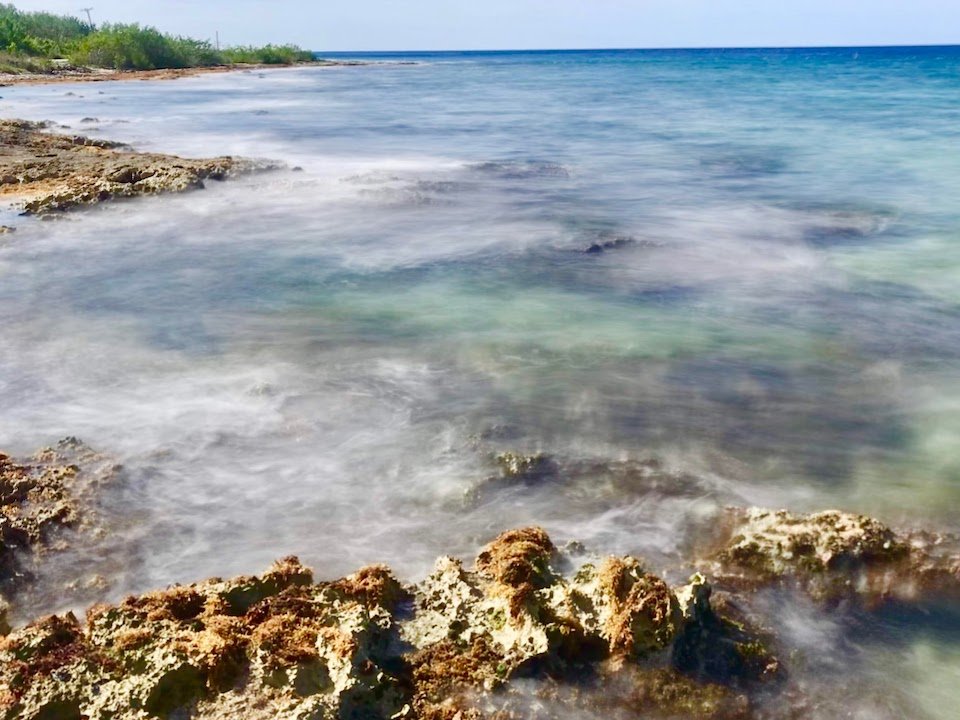
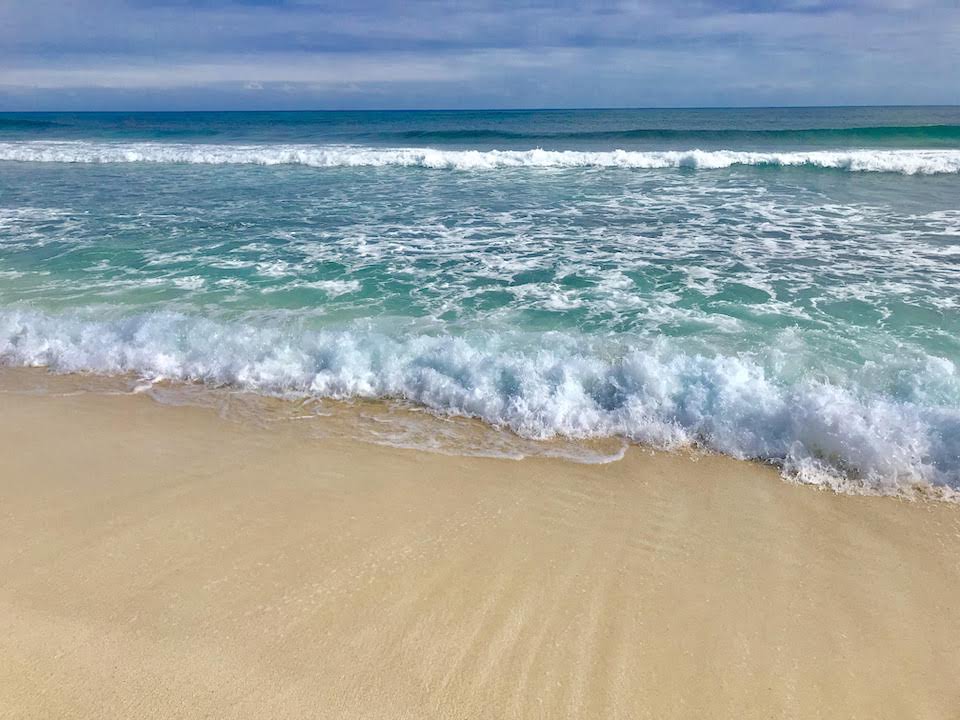
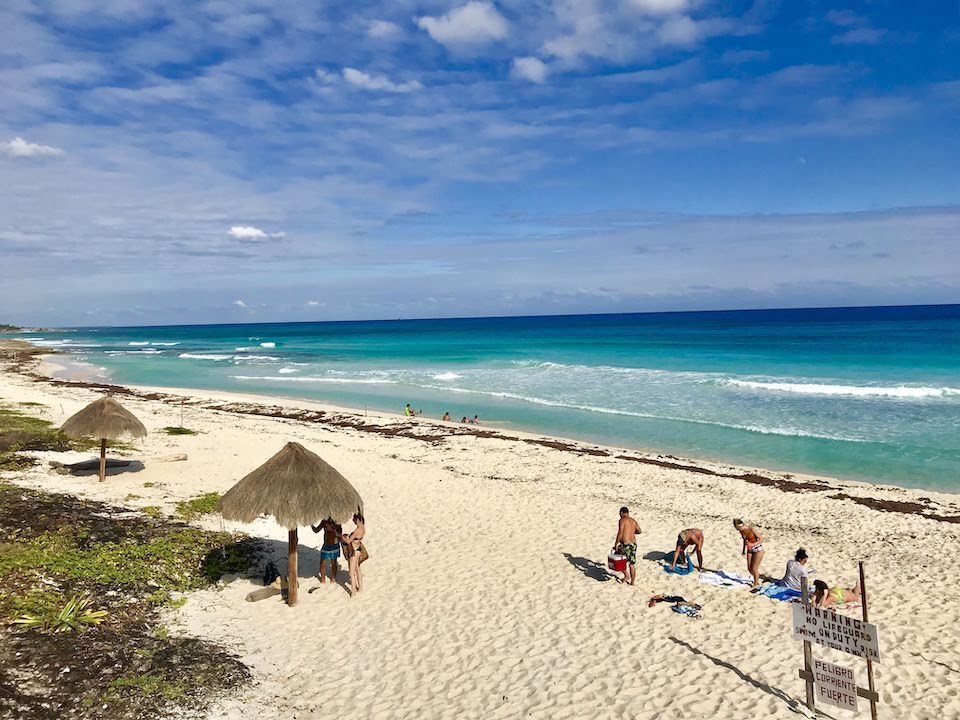
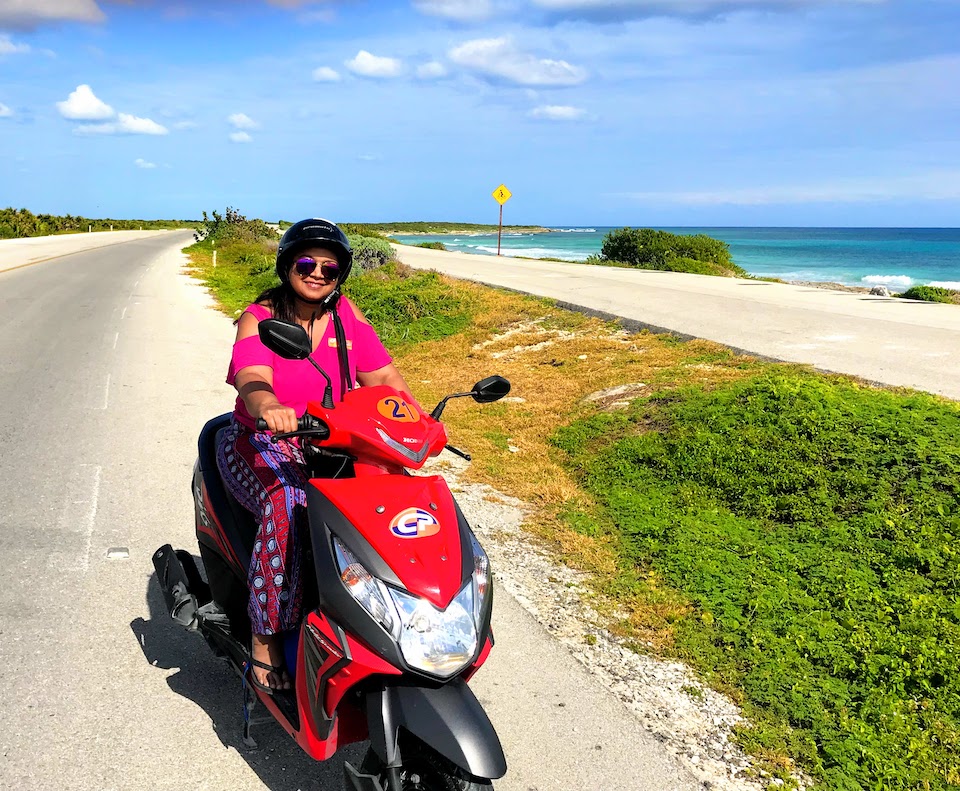
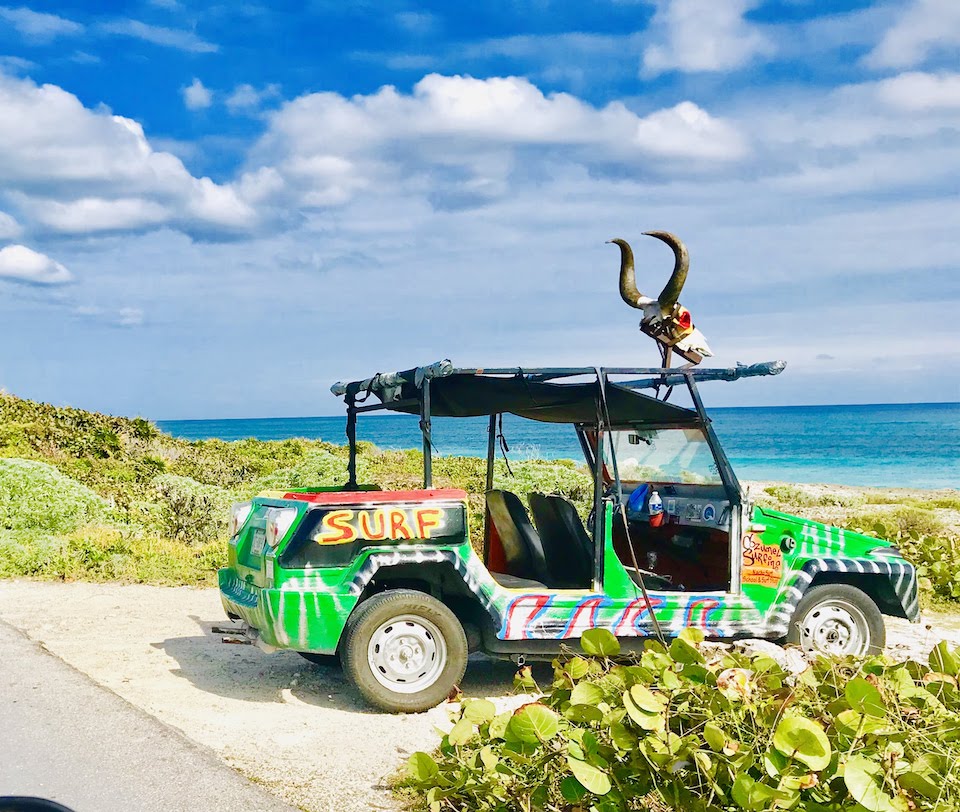
It was a bittersweet moment as it signalled the end of our 2 month long Mexico trip. But we were also looking forward to returning back home and to spending Christmas and New year with our kids. The month we were back home was so short and between the holidays and planning our next trip to Brazil, I never realized how soon time had flown. As I’m writing this, we have actually completed our 3 month tour of Brazil and I can’t wait to write all about the amazing Amazon and all the wonderful experiences of our second South America visit. I hope you are also equally excited to read about it and share in our journey. Until then….


